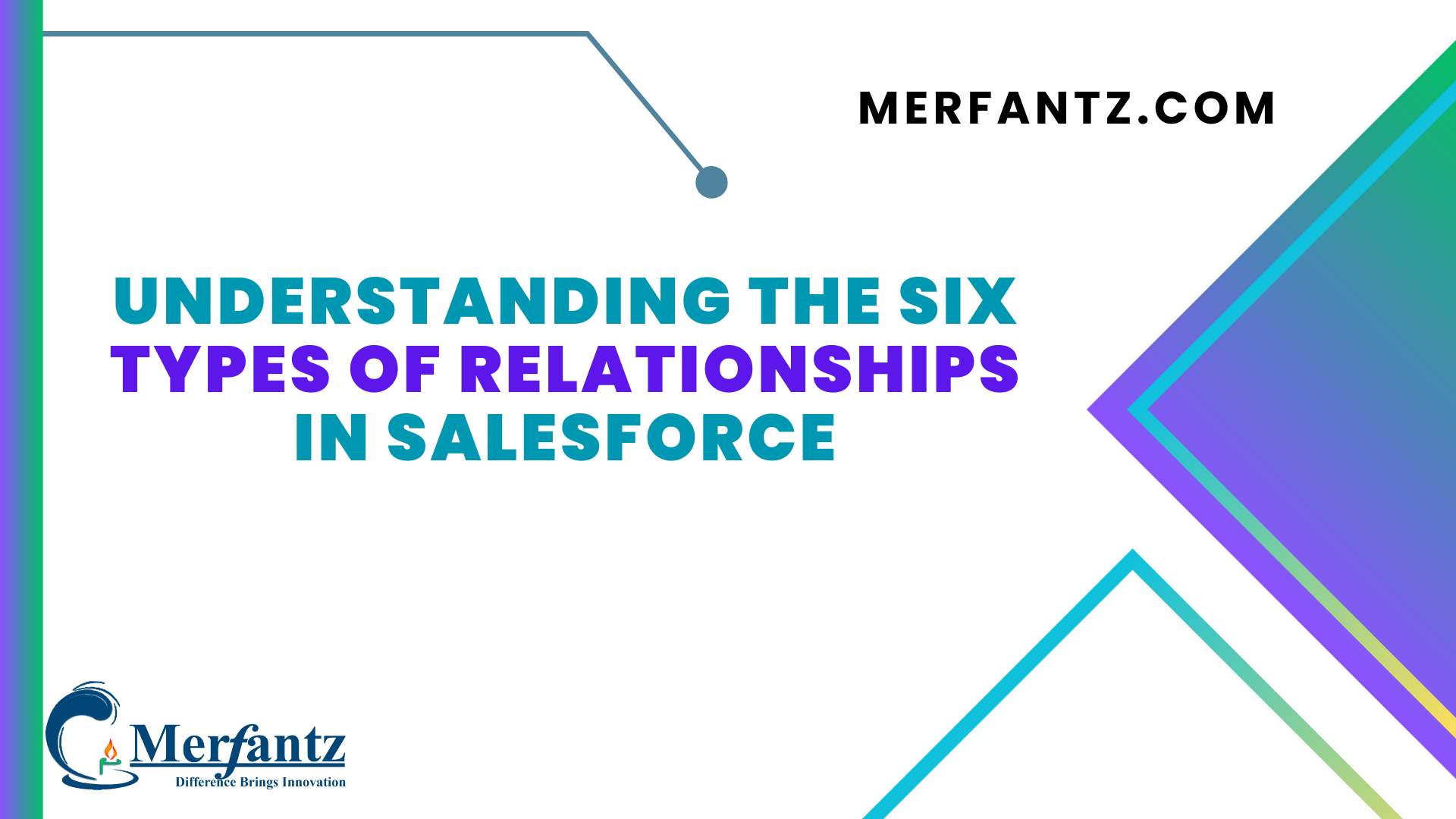When it comes to managing data efficiently in Salesforce, relationships play a pivotal role. Understanding the various types of relationships within the platform can significantly enhance your CRM capabilities. In this comprehensive guide, brought to you by Merfantz Technologies, we delve into the intricacies of Salesforce relationships, exploring their importance and how they facilitate seamless data connectivity.
Introduction to Salesforce Relationships
Salesforce relationships lie at the heart of effective data management, providing a structured way to connect different pieces of information within the CRM ecosystem. These relationships enable businesses to establish meaningful associations between records, facilitating comprehensive insights and streamlined processes. By defining connections between objects, Salesforce relationships empower organizations to create a cohesive view of their data, enhancing reporting accuracy, process automation, and overall user experience. From master-detail relationships that enforce data integrity to lookup relationships that offer flexibility, understanding the intricacies of Salesforce relationships is essential for optimizing CRM capabilities and harnessing the full potential of data-driven decision-making.
In the world of CRM, Salesforce relationships are the building blocks that transform disconnected data points into actionable insights. With these relationships, businesses can track customer interactions, manage opportunities, and maintain a clear understanding of their organizational structure. As you embark on the journey of understanding Salesforce relationships, you’ll gain a deeper appreciation for how these connections shape the way data is organized, accessed, and utilized. This introduction marks the beginning of a comprehensive exploration into the diverse types of relationships that Salesforce offers, each playing a unique role in shaping data relationships and elevating your CRM strategies to new heights.
Master-Detail Relationship
Defining Master-Detail Link
The master-detail relationship represents a parent-child association between records. In this relationship, the master record (parent) controls certain behaviors and attributes of the detail records (children). This connection is vital for maintaining data consistency and enforcing data security.
Use Cases and Benefits
Master-detail relationships are ideal for scenarios where you need tight control over data integrity and ownership. For example, when managing opportunities and their associated line items, the master-detail relationship ensures that line items are deleted when the opportunity is deleted, maintaining accurate sales data.
Lookup Relationship
Exploring Lookup Links
Unlike the master-detail relationship, lookup relationships establish a connection between records without the same level of control and ownership. In a lookup relationship, the “child” record holds a reference to the “parent” record, allowing for flexible data management.
Leveraging Cross-Object Connections
Lookup relationships are versatile tools, especially when you need to link records across different objects. For instance, when associating a contact with an account, a lookup relationship enables you to access account information directly from the contact record.
Hierarchical Relationship
Grasping Hierarchy in Salesforce
Hierarchical relationships are unique in that they establish a parent-child connection within the same object. This relationship type is commonly used for organizational structures, where each record represents an individual and their position in the hierarchy.
Managing Parent-Child Dynamics
Hierarchical relationships enable easy navigation between different levels of an organization. For example, if you’re managing employee records, a hierarchical relationship allows you to view an employee’s manager and their direct reports directly from the employee’s profile.
Many-to-Many Relationship
Unraveling Complex Associations
Unlike the previous relationship types, many-to-many relationships involve multiple records on both ends. This type of relationship is facilitated using junction objects, which serve as intermediaries to connect records.
Implementing Junction Objects
Junction objects allow you to establish connections between records that may not have a direct relationship. For instance, in a scenario where you want to connect products with opportunities, a junction object can help you track which products are associated with each opportunity.
External Lookup Relationship
Extending Relationships Beyond Salesforce
The external lookup relationship takes data connectivity a step further by allowing you to establish links with data outside of Salesforce. This is particularly useful when you need to integrate information from external systems or databases.
Integrating External Data
Integrating external data into your Salesforce environment opens the door to a wealth of new insights and possibilities. External data integration refers to the process of connecting information from sources outside of Salesforce, such as third-party applications, databases, or web services, and seamlessly incorporating it into your CRM platform. This integration empowers businesses to enrich their existing data with valuable context, allowing for a more holistic view of customers, partners, products, and processes.
By integrating external data, organizations can enhance their decision-making processes, improve customer interactions, and streamline operations. This might involve accessing real-time market data, syncing customer information from external databases, or automating workflows that span multiple platforms. With the power of external data integration, businesses can leverage a broader spectrum of information, unlocking the potential for more informed decisions and more personalized interactions across their Salesforce ecosystem.
Self Relationship
Exploring Self-Reference Structures
A self relationship is an intriguing concept that involves creating relationships within a single object. In essence, records within the same object are related to one another, providing a way to model various types of relationships within a single entity.
Practical Scenarios and Insights
Self relationships find application in scenarios like creating family trees or connecting employees within the same organization. By understanding the intricacies of self relationships, you can design data models that accurately represent complex relationships.
Choosing the Right Relationship Type
Evaluating Business Needs
As you explore these relationship types, consider the specific needs of your business processes. Choosing the right relationship type ensures that your data is organized in a way that supports your operations and reporting requirements.
Decision-Making Guidelines
Factors such as data ownership, data consistency, and reporting capabilities should guide your decision-making process. Master the art of selecting the most suitable relationship type for each scenario to maximize the benefits of your Salesforce implementation.
Best Practices for Relationship Setup
Data Modeling Strategies
When setting up relationships, a well-thought-out data model is essential. Define clear naming conventions, establish data validation rules, and ensure that your relationships accurately represent the real-world associations you’re trying to model.
Avoiding Common Pitfalls
Mistakes in relationship setup can lead to data inaccuracies and difficulties in reporting. Learn from common pitfalls such as creating unnecessary relationships or neglecting data security, and adopt best practices to ensure a smooth implementation.
Enhancing Workflows with Effective Relationships
Maximizing Process Automation
Efficiently configured relationships open the door to enhanced process automation. For instance, when a new opportunity is created, a well-structured relationship can trigger automatic creation of associated line items, saving time and reducing manual effort.
Streamlining Data Flow
Smooth data flow between related records results in more accurate reporting and insights. By leveraging relationships effectively, you can streamline data updates and ensure that changes are reflected across interconnected records.
FAQ – Understanding Salesforce Relationships
What is the significance of Salesforce relationships in data management?
Salesforce relationships are crucial for establishing connections between different records in the CRM platform. These connections help maintain data integrity, enable accurate reporting, and streamline processes. By understanding and leveraging relationships, you can create a comprehensive view of your data and enhance your CRM capabilities.
How do master-detail relationships differ from lookup relationships?
Master-detail relationships and lookup relationships both establish connections between records, but they have distinct characteristics. In a master-detail relationship, the “master” record controls certain attributes and behaviors of the “detail” records. On the other hand, lookup relationships link records without the same level of control or ownership. Master-detail relationships are ideal for maintaining data consistency, while lookup relationships offer more flexibility.
What are some practical use cases for hierarchical relationships?
Hierarchical relationships are commonly used to model organizational structures, where records within the same object represent individuals at different levels. This is useful for visualizing reporting structures, understanding chains of command, and navigating through an organization’s hierarchy. For example, you can use hierarchical relationships to track managers and their subordinates within a company.
What are the types of relationships in Salesforce?
There are six types of relationships in Salesforce: Master-Detail, Lookup, Hierarchical, Many-to-Many, External Lookup, and Self relationships.
What is the difference between lookup and master-detail relationship in Salesforce?
The key difference is control and ownership. In a master-detail relationship, the master record controls detail records and has ownership. In a lookup relationship, records are linked without the same level of control or ownership.
What are the types of relationship in Salesforce Trailhead?
Salesforce Trailhead covers various types of relationships, including Master-Detail, Lookup, and Self relationships, providing hands-on learning experiences for each.
What are the different types of relationship in Salesforce interview questions?
In Salesforce interviews, you might encounter questions about Master-Detail, Lookup, Hierarchical, Many-to-Many, External Lookup, and Self relationships. Be prepared to explain their purposes and use cases.
Conclusion
In the world of Salesforce, relationships are the backbone of data management. Each relationship type serves a distinct purpose, allowing you to capture the rich associations that define your business processes. As you navigate through master-detail, lookup, hierarchical, many-to-many, external lookup, and self relationships, keep in mind the unique benefits they bring to your CRM implementation.
At Merfantz Technologies, we’re dedicated to helping you master the art of Salesforce implementation. By understanding and harnessing the power of these relationships, you’re poised to create a data ecosystem that drives operational excellence, informed decision-making, and seamless user experiences. Explore the potential of Salesforce relationships today, and unlock a new level of CRM efficiency.
Author Bio
Co-Founder & CMO at Merfantz Technologies Pvt Ltd | Marketing Manager for FieldAx Field Service Software | Salesforce All-Star Ranger and Community Contributor | Salesforce Content Creation for Knowledge Sharing






